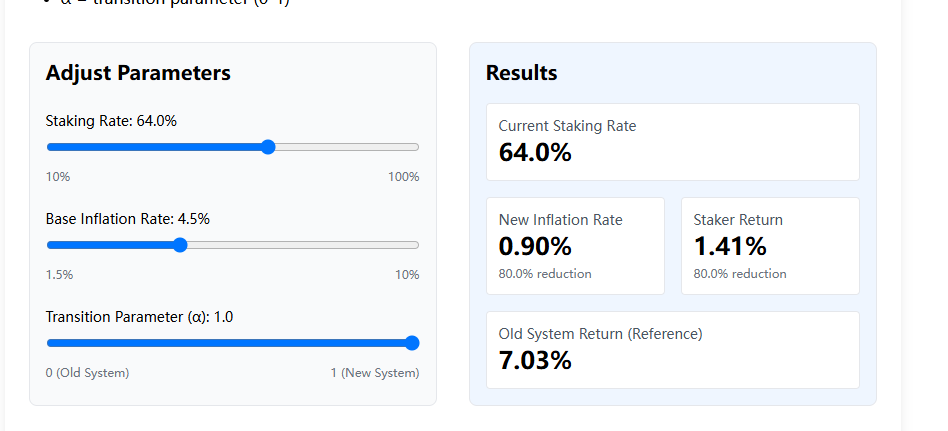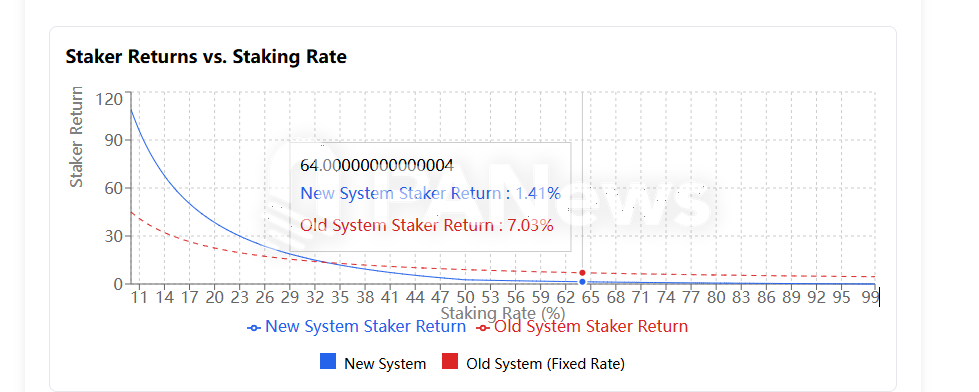Recently, the Solana governance forum launched a proposal called SIMD-0228, which aims to dynamically adjust the inflation rate, reducing the annual issuance of SOL by 80%, and guide funds from staking to .
However, this seemingly "smart issuance" blueprint has sparked fierce debates in the community about the "inflationary spiral" and the struggle of interests - when the staking rate falls below the critical point, higher inflation may backfire on market confidence. The revenue structure of validators and the distribution of benefits to ecosystem participants have become the hidden bombs in this experiment of token economics.
The new proposal may reduce the inflation by 80%, reducing the annual issuance of 22 million SOL
The token issuance mechanism of Solana's SOL has always adopted a fixed schedule, with the inflation rate declining by 15% annually from 8% until it reaches the target of 1.5%. The current inflation rate is 4.694%. Under this inflation rate mechanism, the number of tokens issued this year is about 27.93 million, with a staking rate of around 64%.
In comparison, the current inflation rate of Ethereum is around 0%, with a staking rate of around 30%. The inflation model of SOL tokens is obviously less conducive to token value preservation, and the high inflation rate has led to a large amount of tokens being staked to obtain higher yields. This is not beneficial for the development of the ecosystem.

The proposal believes that currently, MEV revenue has become the main source of income for Solana network validators, and reducing the staking yield will not have a significant impact on their earnings. "In simple terms, it is a foolish issuance. Given the thriving economic activity on Solana, it makes sense to develop the network's monetary policy to achieve smart issuance."
The proposal sets a threshold, initially assumed to be 50%, where if the staking rate exceeds 50%, the inflation rate will decrease, reducing the network's staking rewards. When the staking rate falls below 50%, the inflation rate will be increased to incentivize more capital to be staked.
Subsequently, forum users questioned the lack of rigorous calculation basis for the 50% threshold, considering it to be set too hastily. The proposer then provided a new algorithm curve, setting 33% as the threshold, where the annual inflation rate will be lower than the current rate when the staking rate is above 33%.
According to calculations, using the current 64% staking rate as an example, the annualized inflation rate will decrease from 4.694% to 0.939%, a reduction of about 80% under the new token issuance curve.
If the proposal is ultimately approved, and the current staking rate is maintained, the annual issuance of SOL will decrease from 27.93 million to 5.59 million.

However, this proposal does not seem to have reached a consensus in the forum, and many comments believe that if the plan is implemented, the reality may not unfold as ideally. For example, when the staking rate declines, the rise in inflation rate may further reduce market expectations for the token, which could lead to further sell-offs of unstaked tokens, triggering greater uncertainty.
calculations show that when the staking rate is only 25%, it will generate 44.13 million tokens in inflation, far exceeding the current inflation rate.
If this inflationary spiral occurs, the result may be counterproductive. As the proposal states, the current source of income for validators is MEV revenue. This phenomenon is mainly due to the active trading on the Solana network and the high demand from MEME players for transaction speed and protection against sandwich attacks, making MEV revenue a significant portion. If the overall transaction volume on the network declines in the future, the proportion of MEV revenue may be difficult to maintain as the primary source of income for validators. At that time, if combined with the double blow of inflation and price decline, it may further dampen the enthusiasm for staking, leading to a reverse spiral of rising inflation and declining staking.
The giant validators remain silent, which may be a power struggle between large token holders
The proposal was initiated by Vishal Kankani, an investor at Multicoin Capital, which is an early investor in , leading a $20 million Series A round in 2019. Multicoin Capital holds a large amount of tokens, choosing to obtain them through early investment rather than equity. From this background, Vishal Kankani represents the interests of large token holders, who are more sensitive to the impact of inflation on token market prices.
Interestingly, as of February 26th, major Solana network validators such as Helius, binance staking, and Galaxy have not expressed their stance on this proposal. The founder of Helius, who frequently comments on the development of the ecosystem, has only reposted a related content and commented that it is foolish to sell tokens now.
In fact, if this proposal is approved, it may not be good news for validators like Helius, who return 100% of MEV revenue to stakers, as they may be more dependent on the staking rewards themselves due to not capturing the benefits from MEV.
Overall, this proposal represents the interests of large token holders, who hope to reduce inflation to achieve price stability. Furthermore, from an ecosystem perspective, the current staking yield on the network is around 7.03%, and under the new proposal, the yield will drop to 1.41% at the same staking rate, a decrease of nearly 80%. This is not good news for large validator nodes that hope to obtain risk-free returns through staking.

Of course, the proposal believes that the decrease in staking rewards will incentivize these validators to invest more of their tokens into the ecosystem, which can further enhance the prosperity of the ecosystem.
This token economic reform in is essentially a power rebalancing between large token holders, validators, and ecosystem builders. If the proposal is approved, the staking yield of 7.03% may plummet to 1.41%, forcing validators to shift from relying on inflationary rewards to focusing on MEV and transaction fees - this is both an opportunity and a gamble.
If DeFi can attract tens of billions of dollars in idle liquidity, Solana may see an explosive innovation like Uniswap and Aave; but if the market sells off due to a drop in yields, the massive issuance of 44.13 million tokens at a 25% staking rate could drag the network into a "inflation - sell-off - more inflation" death spiral.
Currently, the silence of top validators like Helius suggests a delicate tension in the chain of interests - when the business model of 100% MEV return encounters a halving of the base revenue, the "decentralization" narrative of the ecosystem may face a reality check. The stance of Multicoin Capital as an early whale also reveals the deeper logic of this game: in the eyes of institutional investors, the value storage property of SOL takes precedence over the need for network security. In the coming months, as the March 7th vote approaches, Solana's fate will no longer be dictated by the code alone, but will depend on whether the community can find that dangerous balance point between idealism and capital rationality.







